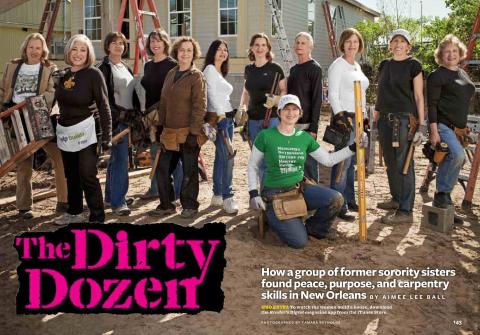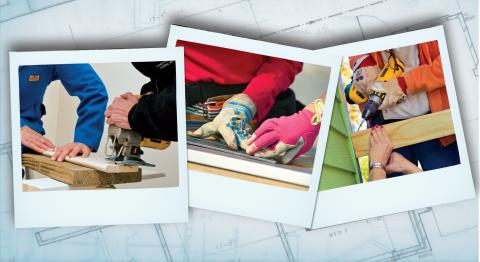The Dirty Dozen: Rebuilding New Orleans after Katrina

When Hurricane Katrina devastated New Orleans, a dozen Newcomb College alumnae felt called to help. It all began when Cheryl Josephs Zaccaro (NC ’69), a retired occupational therapist, signed up with Habitat for Humanity in February 2006. Moved by the scale of the need in New Orleans, she returned that December — and brought along some of her Sigma Delta Tau sorority sisters.
What began as a single week of service became a yearly tradition.
Rachelle Galanti Parker (NC ’69) remembers how unusually chilly that first December, 2006, in New Orleans felt. Many of the women hadn’t reunited in years, but they joined forces and rolled up their sleeves to rebuild together. “We came together, and honestly, it became a team effort,” said Parker, now a retired elementary school principal from New York City.
I have never been a person who's done physical work around houses. But that was, for me, so exciting. I learned to paint. I learned to get up on roofs and ladders.
Rachelle Galanti Parker (NC '69)
The group included mostly alumnae from the class of 1969 (with a few from 1971), representing different schools and majors. They came from across the United States and worked in various careers, including teaching, social work, law, communications, finance and marketing. Some still held full-time jobs, while others had retired. They were on different paths with distinct personalities, but they came together for the greater good.
Their efforts not only supported the city’s recovery but also rekindled lifelong friendships. “This reawakened our love for the city,” said Janis Dropkin Smythe (NC ’69), now a retired commercial music producer living in Florida. “Some of the women I hadn’t seen between graduation and Katrina — now I see them all the time.”
The New Orleans that the women arrived at that first December when they volunteered — more than a year after Hurricane Katrina — was in full recovery mode, with many New Orleanians still displaced, living in other cities or in FEMA trailers. Entire neighborhoods were still deserted and showed visible standing floodwater marks.
Under Habitat for Humanity’s training, the Newcomb alumnae pitched in fully: hammering nails, sawing wood, spackling walls, building chain-link fences, installing siding and cabinets and more.
Before 2006, Parker said she had little experience with house construction, which made the physical labor deeply meaningful. “I have never been a person who’s done physical work around houses. But that was, for me, so exciting. I learned to paint. I learned to get up on roofs and climb ladders.”
They became known as the “Dirty Dozen,” a nickname coined by a journalist in a 2011 Reader’s Digest article that chronicled their work. Their dedication and spirit caught national attention, earning them a spot on “The Queen Latifah Show” in 2013.
The first Habitat home they worked on belonged to Kewanda Baxter, a single mother of three whose house in New Orleans East had been destroyed by Katrina. Now living in Musicians’ Village in the Upper Ninth Ward, Baxter became a friend. The alumnae have stayed connected with her for 19 years, gathering for dinners when they’re in town, and Carolyn “Puddin” Brown Cox (NC ’71) has kept the bond strong: if Baxter needs support — repairs to her kitchen, tutoring for the children — Baxter reaches out to Brown, who rallies the alumnae network to help.
Shala Carlson (NC ’93), a member of the Newcomb Institute Director’s Advisory Council and Habitat for Humanity International’s senior director of brand and content strategy, is inspired by the group’s long-time dedication, which she says is essential to the survival of cities that experience disaster.
“It’s easy in the immediate aftermath [of a disaster] because you see it everywhere, and you want to stand up and do something. But these are people who have committed over the long term to keep coming back. I love that they love New Orleans enough to want to come back and do this, and that Habitat could provide the forum for them to do that in a really meaningful way.”
The recovery of New Orleans after Hurricane Katrina would not have been possible without the help of volunteers, like the Dirty Dozen, who came from across the country and around the world. From gutting homes to rebuilding entire neighborhoods, volunteers played a vital role in helping the city rebound. Most of the alumnae are now in their late 70s, and while they may spend less time wielding hammers, they continue to return to New Orleans regularly — supporting local businesses, catching up over long meals, and deepening friendships that began more than 50 years ago. Their commitment to the city — and to each other — remains as strong as ever.
Their shared history, forged in Newcomb’s all-women dorms and sorority life, grew even stronger through the experience of giving back. “It definitely deepened and enriched my friendships,” Parker said. “We love each other, and I have to say that it was Newcomb College that created that bond.”
Smythe said that giving back sparked something lasting: many of the women now visit New Orleans more often, not just for the volunteer trip. She herself comes several times a year. “It’s almost like a second home. It’s become more a part of my life than it was before Katrina.”
For Parker, too, her connection to New Orleans and Newcomb has grown stronger. She became a member of Newcomb Institute’s Director’s Advisory Council four years ago, and she hosts Newcomb students and alumnae in her New York City home. “I love New Orleans more.” She now has another personal tie to Tulane — her grandson is a rising sophomore.
Plans are already underway for another return in 2026 — a testament to the friendships they’ve rebuilt and the lasting foundation of love they’ve laid for the city.
Caption for image on page 4: Amy Goldberger, Sandy Daum Berman, Janis Dropkin Smythe, Linda Lewis-Moors, Carol Nathan McKegney, Sydney Fleischer Camp, Sharon Graber Purcel, Cheryl Josephs Zaccaro, Marilyn Zwick Storch, Carolyn "Puddin" Brown Cox, Debbie Brown Britt, and Rachelle Galanti Parker take a break from the construction of a Habitat for Humanity house on Ferry Place in December 2008. It was the group's third rebuilding trip to the city.


